Broadband Equity Access and Deployment Program (BEAD) Overview
The BEAD program is unique in the realm of broadband funding as it consists of a two-tiered system in which the National Telecommunications and Information Administration (NTIA) distributes program formula funding to states, who then host subgrant competitions to distribute the funding. BEAD funding is sequenced as an iterative process (detailed in Section IV.B of the BEAD NOFO) to drive resources to states based on review and acceptance of five-year action plans which then guide state proposals including both statewide and municipal initiatives. Subgrant competitions for cities are defined in Volume 2 of the Initial State Proposal. The timeline for BEAD program implementation will vary by state as it is dependent on the timing of other state milestones related to required steps for receiving BEAD funding. At publication, many states’ initial proposals are in the public comments phase. The National Telecommunications and Information Administration has a webpage for public notice postings of BEAD and Digital Equity plans and proposals. State subgrant competitions are expected to be held in CY 2024. With this structure, there is likely to be variance in subgrantee requirements across states.
Considerations for municipal leaders
These case studies raise several considerations for municipal leaders and stakeholders as strategies for broadband deployment are developed, including:
- What are your goals for community connectivity and how do they align with priorities for equity, economic mobility and competitiveness?
- What are the challenges facing your city in terms of closing equity gaps and spurring economic development – physical access, affordability, or something else?
- What is the existing physical infrastructure and who is in the market?
- What funding and financing options are available to your city?
- What local partners do you have or need to build a successful project? How can you best engage with them?
- What is the level of community support? How do community stakeholders see the trade-offs in different models for broadband upgrades?
- What organizations and resources can you work with to provide access to digital technology (including computers) and support digital literacy?
- How will you ensure that eligible households can access benefits provided by the FCC’s Affordable Connectivity Program?
Fiber Network Buildout Project in Waterloo
Project Leadership:
- Mayor Quentin Hart
- Andy Van Fleet, Chair of Waterloo’s Municipal Communications Utility
Location: City of Waterloo
Focus: Broadband infrastructure, economic mobility
The Waterloo Municipal Communications Utility (MCU) was established by a citywide vote in 2005 with the vision of deploying a locally owned, controlled, and operated telecommunications utility. Following the increased need for reliable and affordable internet service during the COVID-19 pandemic, the City of Waterloo and Waterloo MCU decided to move forward with a city-wide fiber network buildout, supported by federal funding in addition to municipal bonds.
The project consists of two (2) components:
- Construction of a fiber backbone to support municipal operations, and
- Build out and delivery of “next-generation fiber-to-the-premises (“FTTP”) services, enabling high-speed internet access to every home and business in Waterloo
Impacts of the project for the Waterloo community will be visible in a faster, more reliable, and accountable community-based internet service provider (ISP). The community-led ISP will ensure residents have access to remote work and learning opportunities, provide substantial monthly savings on internet service, and create over 170 jobs within the city.
Projected Community Impact
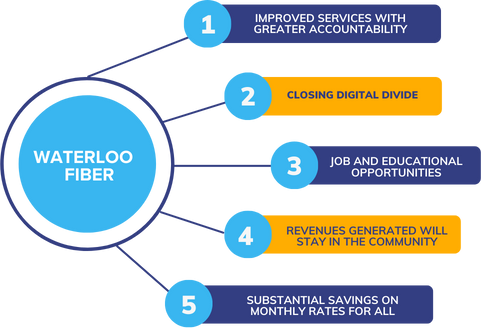
Problem to Solve
Residents of Waterloo have historically lacked access to affordable and reliable broadband connections. Per a 2019 survey and market analysis from the Waterloo Industrial Development Association (WIDA), of 340 respondents, 43% were “very dissatisfied or dissatisfied” with the current provider, and about 77% of respondents would be likely to switch providers if another offered superior service at a better price. In 2019, the City Council allocated funds to complete a feasibility study for developing a municipal broadband network throughout Waterloo; Magellan Advisors were hired to conduct this study starting in January 2020. Through the study and feedback from residents, the City recognized that gaps in broadband access and reliability issues were exacerbated by the onset of the COVID-19 pandemic in 2020. During this time, it became clear that latency and unstable connections were creating challenges for residents who could not access remote work and learning opportunities, utilize telehealth resources, or rely on hot spots. Eventually as part of the feasibility study, a March 2022 survey of over 2,700 respondents would find that the top concerns for broadband were reliability, price, and speed of current internet services.
Waterloo MCU was established in 2005 by a municipal referendum, but lacked sufficient funds to pursue capital investment of the scale necessary for the broadband goals demanded by residents. By 2021, the confluence of digital equity disparities, COVID-19 impact, and available federal funding authorized by the American Rescue Plan Act and distributed by EDA, allowed Mayor Hart and the City of Waterloo to pursue the project through their municipal telecommunications utility.
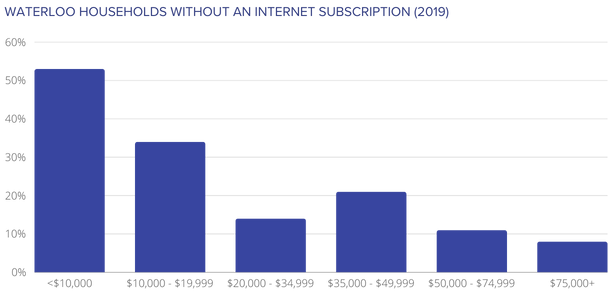

Partner Engagement
Mayor Hart has engaged with the local and regional business community through the WIDA, Waterloo Chamber of Commerce, and Grow Cedar Valley. These organizations have participated in and supported the broadband feasibility studies and surveys for project planning. The business community has also backed the City’s efforts to advocate for, apply for, and access various funding sources at the federal level. By partnering with other city services for the fiber backbone component in support of smart city innovations in Waterloo, the Waterloo MCU can access additional city funds and financial support. Waterloo MCU has already received a commitment of $3M from Waterloo Water Works; other city departments such as waste management and traffic operations may provide further support.
Mayor Hart has also engaged with local and regional governmental entities such as the school district, the Iowa Northland Regional Council Of Governments (INRCOG), and a neighboring municipal broadband network, Cedar Falls Utilities (CFU). INRCOG is funded by the EDA to bring together the public and private sectors to create an economic development roadmap to strengthen the regional economy, support private capital investment, and create jobs; their leadership in regional planning efforts and grant writing support contributed significantly to the success of Waterloo’s broadband project. Engagement with CFU is enabling an accelerated buildout of Waterloo’s broadband network. CFU’s existing fiber infrastructure near a southern Waterloo fire station is allowing the city to build inwards toward the city center using the station as a starting point. This strategy allows for a three (3) year project timeline, whereas, according to the Mayor, building out from the city center with brand new infrastructure would take closer to five (5) years.
Funding Waterloo Fiber
The bid approved for this project was priced at approximately $78M.
The City, following on advocacy efforts at the federal level, received $25M for their broadband project from the ARPA, as well as a $1.8M EDA grant available through the ARPA’s Economic Adjustment Assistance Program. The EDA grant requires a local match of approximately $668K in funds sourced from locally raised Waterloo Tax Increment Financing (TIF). Magellan Advisors supported the City’s efforts to secure the EDA grant. Additionally, a September 2022 referendum, passed with 84% support (well above the 60% threshold for approval), has allowed the City to issue up to $20M in government obligation bonds for the project. Per Andy Van Fleet, Chair of the Waterloo MCU, these municipal bonds will not go against property taxes, but rather are “looking at the future revenues from the utility and bonding against those.” The City will also be financing remaining shortfalls through Telecommunications Revenue Bonds that are bonded explicitly against the MCU’s revenue earnings. For comparison, Cedar Falls Utilities in the neighboring city of Cedar Falls, which includes broadband in its services, had an annual net income of $4.88M; noting that Waterloo has twice as many homes as Cedar Falls, Van Fleet touts that not only does the Waterloo MCU have profit-making potential, but also those profits will stay in Waterloo.
The city will also use $8.5M in Sewer Revenue Bonds and $2.75M through a Water Revenue Contribution from Waterloo Water Works for the fiber backbone component that will support smart city innovations promoting interconnected city services.
While the City successfully secured federal funds to support project expansion, their grant application for NTIA’s Middle Mile Program was unsuccessful, partially due to the high number of overall applications submitted – only one project in Iowa received funding through this program. This program is designed to bridge network gaps by funding smaller, local networks with “robust, high-capacity national and regional networks.”
Waterloo recognizes the importance of identifying and pursuing various funding sources to support project development, leading them to partner with local banks for additional financing. The City will also be seeking bids on long term financing for construction costs. Waterloo MCU has set up initial bank accounts with local banks, following a procurement process that saw six (6) proposals; illustrating the high level of interest in supporting the utility from a banking perspective.
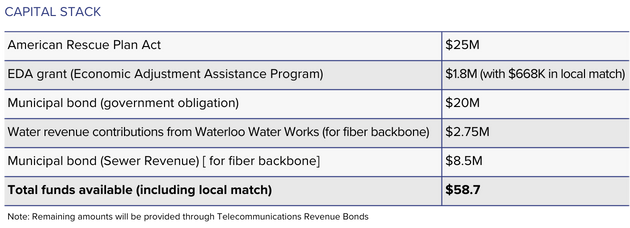
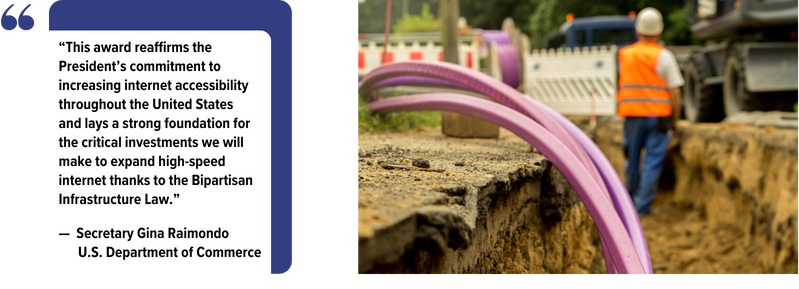
Community Impact
As of August 2023, Waterloo is actively laying fiber and the City expects the first Waterloo MCU customers to connect to the network’s broadband services by the end of 2023. The full impact will be measurable over the next three (3) years as more households and businesses connect to the network and can better rely upon improved services with greater accountability.
Michael Young, an MCU board member, upon the announcement of the rates for the MCU said, “It’s reliable, it’s local but it’s much cheaper than what we’ve been paying.” Based on the approved rates, the Waterloo MCU will provide for substantial savings on monthly rates for all customers – providing four (4) options for internet service (100 Mbps, 300 Mbps, 1 Gbps, and 10 Gbps priced at $29.95, $49.95, $69.95, and $109.95 per month for residential services), all of which have no data caps, no hook-up fees, and allow customers to use locally based service. Waterloo MCU also offers bundled plans including internet, phone, and/or television as well. On the 300 Mbps plan, the MCU rate is almost $80 less per month than market competitors, amounting to annual savings of $950 per year. Waterloo Fiber is participating in the FCC’s Affordable Connectivity Program, which provides monthly discounts of up to $30 per month towards internet services for eligible households.
Andy Van Fleet, Chair of the Waterloo MCU, suggested that the new network will “help people work from home better, our [Waterloo’s] students learn better, and then to be an attractive draw for different businesses that are looking to come to a place like Waterloo that has a Gigabit service.” The Waterloo Fiber website states that revenue generated by the MCU will stay in the community, “paving the way for future technological and community enhancements that will strengthen Waterloo’s quality of life and its economic development potential.”
Per the Department of Commerce’s announcement of the $1.8M grant through EDA’s Economic Adjustment Assistance Program, “This project will construct a middle mile fiber network, supporting business growth, telemedicine connectivity, and virtual educational opportunities. The EDA investment will be matched with $667,682 in local funds and is expected to create 177 jobs, according to grantee estimates.”
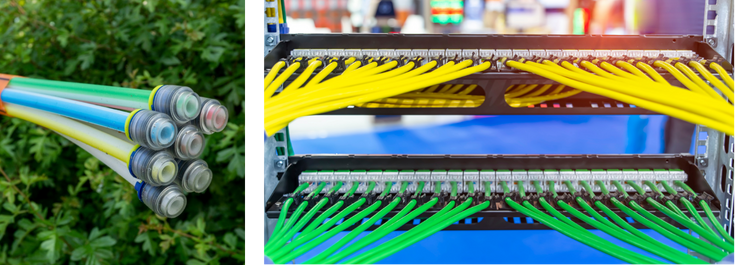
In addition to upgrading broadband connections to residential and business establishments, the fiber network will enable the city to invest in smart city innovations to allow 24/7 access to e-government services, investments in connected parks, and utilization of advanced traffic management systems.
Now, Waterloo residents will be building out the fiber network, servicing the lines and systems, and working with resident subscribers. Through the Waterloo owned and operated network, residents will have confidence knowing that when they call a customer service operator, the individual on the phone is local and understands their community. As Mayor Hart said, the goal of this project is to “help who we have now, and build the infrastructure of tomorrow, today” through this community-driven and locally owned approach.
Conclusion
At the onset of the COVID-19 pandemic, like everywhere else in the country, Waterloo saw a crisis of connection unfolding that adversely impacted their most vulnerable residents. From their workforce to their classrooms, Mayor Hart and his city and municipal utility colleagues were faced with identifying solutions that would ease the transition to remote work and learning and better prepare the city for a remote future. To do so, the Mayor and his team reignited efforts from fifteen years prior to establish Waterloo’s very own municipal fiber network. Leveraged by an injection of funds from the American Rescue Plan Act, EDA, regional partnerships and the full support of his community through a widely passed bond referendum, Mayor Quentin Hart and the City of Waterloo are now on track to offer faster, more affordable, and locally owned and operated broadband services to their residents with the first connections being made by the end of 2023.
Accelerator for America would like to thank Drexel University Nowak Metro Finance Lab for their partnership in production of this case story for the Local Infrastructure Hub.



